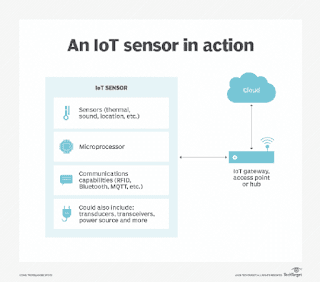Sensors and Embedded System
Sensors and Embedded Systems
A sensor is a device or module (or subsystem) that can sense or detect physical phenomena in the environment, such as light, pressure, temperature, or motion. The input to the sensor can be any physical phenomenon, but the output should be a human-readable signal. Sensors detect changes and events in the surroundings and send data to smart devices and embedded systems. There are different types of sensors for different purposes. These include image sensors, motion sensors, position sensors, photoelectric sensors, radiation sensors, temperature sensors, pressure sensors, proximity sensors, particle sensors, metal sensors, liquid level sensors, electrical sensors, humidity sensors, flow sensors, leak sensors, Flame sensor, contact sensor, non-contact sensor.
In general, sensors can be divided into two categories: active and passive. An external power supply is required to operate the active sensor device. Emit energy pulses and detect energy pulse reflections. The most commonly used active sensor system is RADAR (Radio Detection and Ranging). Passive sensing devices detect or measure naturally occurring energy without requiring an external power source to operate. Active detection systems use passive detection devices to detect reflections.
Sensors can also be classified as analog and digital. Digital sensor devices generate digital signals into which the data is converted and transmitted. Examples of digital sensors include digital accelerometers, digital pressure sensors, and digital temperature sensors. Analog sensor devices generate analog signals. Examples of analog sensors are light sensors (LDR), sound sensors, and analog temperature sensors.
embedded system sensors
An embedded system is a combination of microprocessor-based computer hardware and software designed for a dedicated function. Today, every aspect of modern technology life requires embedded technology: the Internet of Things (IoT), robotics, industrial machinery, medical and agricultural equipment, self-driving cars, drones, planes, toys, and more.
What exactly is a smart sensor?
A smart sensor is a device that receives input from the physical environment, processes that input using built-in compute resources, and then transmits the processed data.
Smart sensors make it possible to collect environmental data more precisely, automatically, and with a smaller amount of false information mingling with true data. These gadgets are used in a wide range of environments, such as smart grids, battlefield reconnaissance, exploration, and many scientific applications, such as monitoring and control mechanisms.
How do intelligent sensors operate?
A smart sensor connects a simple base sensor to built-in computing power to process the sensor's input. The element that offers the ability to sense is the base sensor. It might be made to feel pressure, light, or heat. Frequently, the base sensor will generate an analog signal that needs to be altered before use. This is where the built-in technology of an intelligent sensor is useful. The sensor signal is transformed into a usable, digital format by the onboard microprocessor, which also removes signal noise.
SFIA level
After completing this activity I can say that I am on level 3 which is Apply.
I was able to work under general direction. Receives specific direction, accepts guidance, and has work reviewed at agreed milestones. I have been able to identify and respond to complex issues related to my own assignments such as the Arduino project. Determines when issues should be escalated to a higher level. I have planned and monitored my own work and that of my other classmates competently within limited deadlines.
I interact with and influence my classmates. I have to make decisions that impact routine work assigned to individuals or stages of projects. I have Understands and collaborate and representation in my work.
I have been able to perform a range of work, sometimes complex and non-routine, in a variety of environments. I have applied a methodical approach to my work and moderately complex issue definition and resolution. I have applied and contributed to creative thinking or finds new ways to complete tasks.
Effectively applies digital skills and explores these capabilities for their role.
I have taken the initiative to develop my own knowledge and skills by identifying and negotiating appropriate development opportunities.
I can Demonstrate effective application and the ability to impart knowledge found in industry bodies of knowledge and I can Absorb new information and applies it effectively.
References
https://www.google.com/search?q=embedded+systems&tbm=isch&ved=2ahUKEwjciPWumIT-AhU3kScCHU0BAxwQ2-cCegQIABAA&oq=em&gs_lcp=CgNpbWcQARgAMgQIIxAnMgQIIxAnMgoIABCKBRCxAxBDMgcIABCABBATMgcIABCABBATMgcIABCABBATMgcIABCABBATMgcIABCABBATMgcIABCABBATMgcIABCABBATOgUIABCABDoHCCMQ6gIQJzoHCAAQigUQQzoICAAQgAQQsQNQjwdYiQpgzRNoAXAAeACAAZMCiAHzBZIBAzItM5gBAKABAaoBC2d3cy13aXotaW1nsAEKwAEB&sclient=img&ei=c8glZJyDAreinsEPzYKM4AE&bih=764&biw=1440&hl=en#imgrc=Brcmk1rjLA5XyM




Comments
Post a Comment